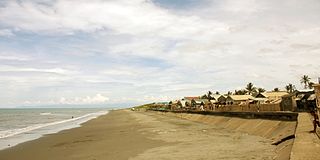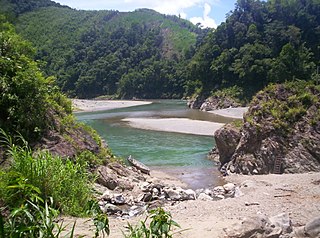
Aparri, officially the Municipality of Aparri, is a 1st class municipality in the province of Cagayan, Philippines. According to the 2020 census, it has a population of 68,839 people.

Cagayan Valley, designated as Region II, is an administrative region in the Philippines. Located in the northeastern section of Luzon, it is composed of five Philippine provinces: Batanes, Cagayan, Isabela, Nueva Vizcaya, and Quirino. The region hosts four chartered cities: Cauayan, Ilagan, Santiago, and Tuguegarao.

Ilocos Norte, officially the Province of Ilocos Norte, is a province of the Philippines located in the Ilocos Region. It is located in the northwest corner of Luzon Island, bordering Cagayan and Apayao to the east, and Abra to the southeast, and Ilocos Sur to the southwest. Ilocos Norte faces the South China Sea to the west and the Luzon Strait to the north. Its capital is Laoag City, which is the most populous in the province.

Ilocos Sur, officially the Province of Ilocos Sur, is a province in the Philippines located in the Ilocos Region in Luzon. Located on the mouth of the Mestizo River is the capital of Vigan while Candon is the most-populous city. Ilocos Sur is bordered by Ilocos Norte and Abra to the north, Mountain Province to the east, La Union and Benguet to the south and the South China Sea to the west.

La Union, officially the Province of La Union, is a province in the Philippines located in the Ilocos Region in the island of Luzon. Its capital is the City of San Fernando, which is the most populous in the province and also the regional center of the Ilocos Region.

Cagayan, officially the Province of Cagayan, is a province in the Philippines located in the Cagayan Valley region, covering the northeastern tip of Luzon. Its capital is Tuguegarao, the largest city of that province as well as the regional center of Cagayan Valley. It is about 431 kilometres (268 mi) northwest of Manila, and includes the Babuyan Islands to the north. The province borders Ilocos Norte and Apayao to the west, and Kalinga and Isabela to the south.

Apayao, officially the Province of Apayao, is a landlocked province in the Philippines in the Cordillera Administrative Region in Luzon. Kabugao serves as its capital. The provincial capitol and its associated offices are located at the New Government Center in Luna. Conner is the most populous town in the province.

The Ilocos Region, designated as Region I, is an administrative region of the Philippines. Located in the northwestern section of Luzon, it is bordered by the Cordillera Administrative Region to the east, the Cagayan Valley to the northeast and southeast, Central Luzon to the south, and the South China Sea to the west.

Cervantes, officially the Municipality of Cervantes, is a 4th class municipality in the province of Ilocos Sur, Philippines. According to the 2020 census, it has a population of 19,449 people.

Santa Maria, officially the Municipality of Santa Maria, is a 3rd class municipality in the province of Ilocos Sur, Philippines. According to the 2020 census, it has a population of 30,006 people.

Maddela, officially the Municipality of Maddela, is a 1st class municipality in the province of Quirino, Philippines. According to the 2020 census, it has a population of 40,943 people.
Perique is a type of tobacco from Saint James Parish, Louisiana, known for its strong, powerful, and fruity aroma. When the Acadians made their way into this region in 1776, the Choctaw and Chickasaw tribes were cultivating a variety of tobacco with a distinctive flavor. A farmer named Pierre Chenet is credited with first turning this local tobacco into what is now known as Perique in 1824 through the labor-intensive technique of pressure-fermentation. It is reported by authorities on tobacco that Perique is based on a variety of Red Burley leaf. The Tobacco Institute says perique has been shipped out of New Orleans for more than 250 years and is considered to be one of America's first export crops.

The lobed river mullet, also known as ludong or banak, is a freshwater mullet. While it is claimed to be endemic to Cagayan River and tributaries extending through the watersheds of Cagayan Valley and the Santa-Abra River Systems of Ilocos Sur and Abra in the Philippines, verifiable and reliable sources have listed Celebes, New Caledonia, New Hebrides, and Fiji as areas where the lobed river mullet may be found.

Partas Transportation Co., Inc. is a bus transportation company in the Philippines. It operates a 24/7 service for passengers and freight between Metro Manila and northern Luzon, with services also running to the Cordilleras in Baguio, Bangued in Abra, and also to the south Occidental Mindoro. Partas also offers chartered service for tour groups.

This article contains a list of tobacco cultivars and varieties, as well as unique preparations of the tobacco leaf involving particular methods of processing the plant.
The Native Tobacco Board, or NTB, was formed in Nyasaland in 1926 as a Government-sponsored body with the primary aim of controlling the production of tobacco by African smallholders and generating revenues for the government, and the secondary aim of increasing the volume and quality of tobacco exports. At the time of its formation, much of Nyasaland's tobacco was produced on European-owned estates, whose owners demanded protection against African tobacco production that might compete with their own, and against the possibility that profitable smallholder farming would draw cheap African labour away from their estates. From around 1940, the aim of the NTB was less about restricting African tobacco production and more about generating governmental revenues, supposedly for development but still involving the diversion of resources away from smallholder farming. In 1956, the activities, powers and duties of what had by then been renamed the African Tobacco Board were transferred to the Agricultural Production and Marketing Board, which had powers to buy smallholder surpluses of tobacco, maize, cotton and other crops, but whose producer prices continued to be biased against peasant producers.

Tobacco smoking in the Philippines affects a sizable minority of the population. According to the 2015 Global Adult Tobacco Survey (GATS) conducted under the auspices of the Philippines' Department of Health, Philippine Statistics Authority, the World Health Organization, and the United States Centers for Disease Control and Prevention, 23.8 percent of the adult population were "current tobacco smokers". This figures represented 16.6 million of 69 million adult Filipinos.
During the administration of former Philippine president Ferdinand Marcos (1965–1986) select businesses were favored and patronized by Marcos, receiving financial support, sole patronage, tax exemptions, and control over entire industries rendering these businesses as monopolies. Friends and relatives of Marcos acquired staggering wealth and economic power due to special favors and privileges extended by the administration. While Marcos associates enjoyed government bailout even during the decline of their firms, other businesses suffered high taxes, sanctions, and other unjust treatments that forced them to close up, or to sell their shares. The majority of monopolies linked to Ferdinand Marcos are managed by his close associates, also regarded as cronies by critics. Former First Lady Imelda Marcos insinuated that the Marcoses controlled the majority of the industries in the Philippines. In a 1988 interview, she stated, "We practically own everything in the Philippines—from electricity, telecommunications, airline, banking, beer and tobacco, newspaper publishing, television stations, shipping, oil and mining, hotels and beach resorts, down to coconut milling, small farms, real estate and insurance."

In May 2017, the House of Representatives of the Philippines began an investigation into alleged misuse of tobacco excise tax funds in the province of Ilocos Norte from 2010 to 2016, representing the first two gubernatorial terms of Imee Marcos, who was serving her third and last gubernatorial term at the time the investigation was initiated. Marcos, her longtime partner Mark Chua, and six Ilocos Norte local officials - Pedro Agcaoili, Eden Batulayan, Josephine Calajete, Encarnacion Gaor, Genedine Jambaro, and Evangeline Tabulog - were implicated in the investigation.
The Mount Data Peace Accord is a peace deal signed between the government of the Philippines and the Cordillera People's Liberation Army on September 13, 1986, ending hostilities due to the latter's campaign for greater autonomy for the Cordillera region.



















